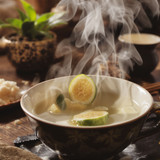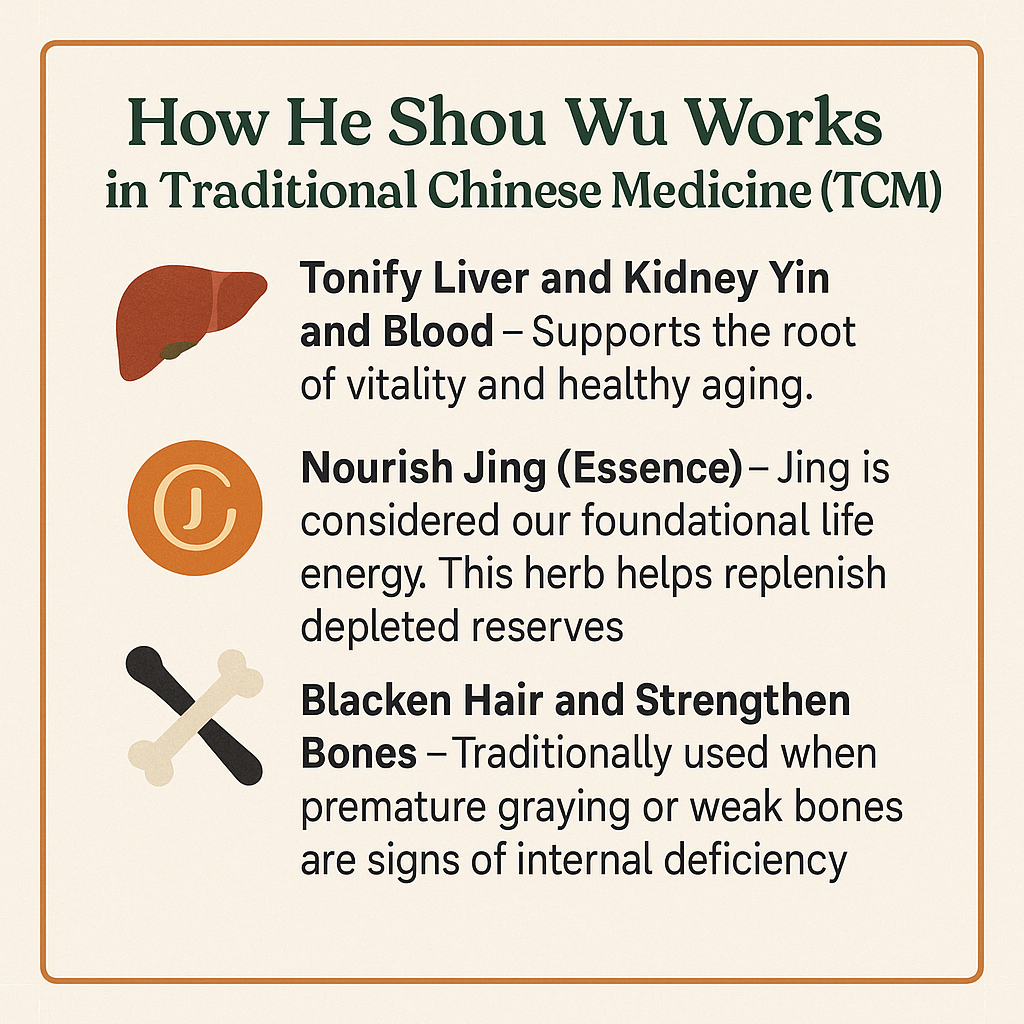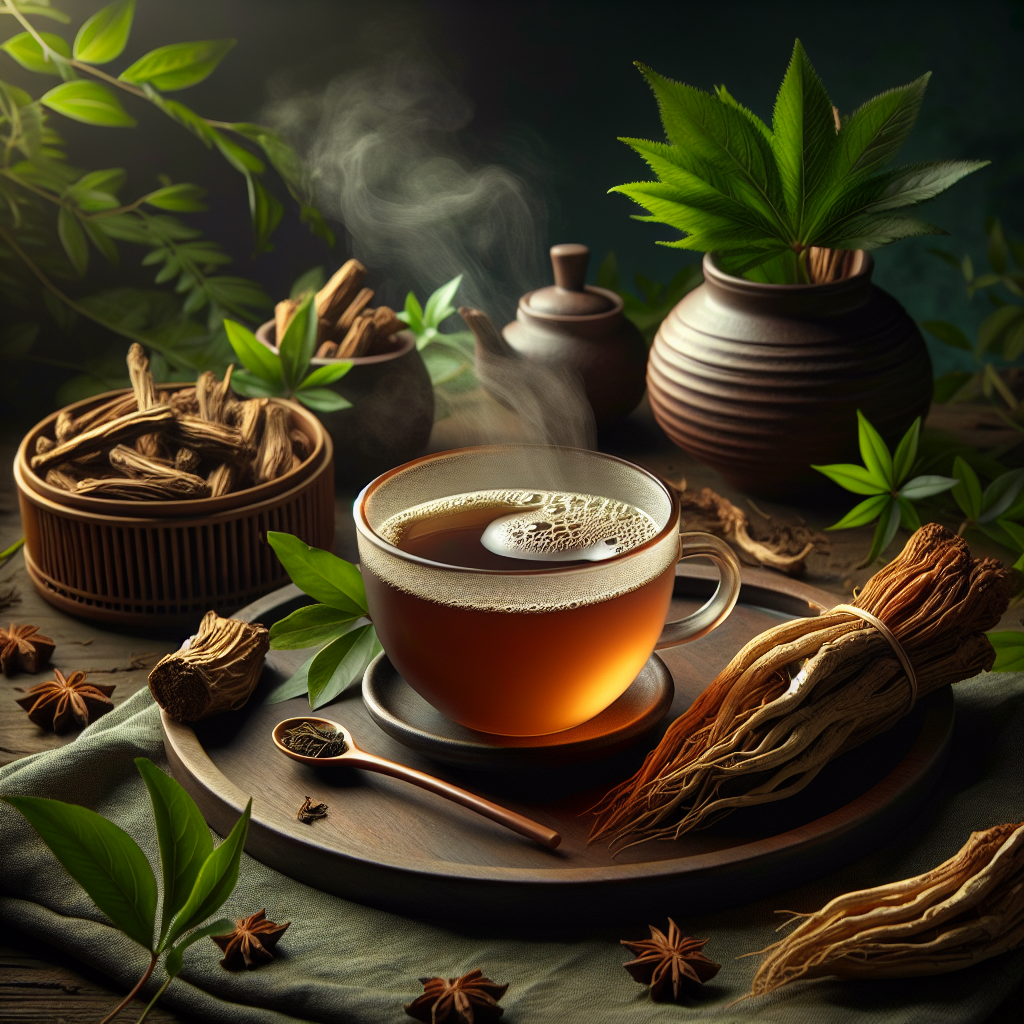

Starwest Botanicals
Organic White Tea Bags
White Tea Bags vs. Green Tea: Why They’re Different White tea and green tea come from the same plant—Camellia sinensis—but they’re made differently. That difference in processing is why white tea...
He Shou Wu, also known as Fo-Ti or Zhi Shou Wu, is one of Traditional Chinese Medicine’s most famous longevity herbs. Revered for centuries for its rejuvenating properties, this powerful root is best known for supporting hair growth, nourishing the liver and kidneys, and promoting vitality as we age. Whether you’ve heard the folklore or you're seeking an all-natural tonic to restore energy and essence, He Shou Wu has a story to tell—and results to deliver.
He Shou Wu (Fo-Ti) is a revered Chinese herb known for promoting hair growth, nourishing the liver and kidneys, and restoring youthful energy. Backed by Traditional Chinese Medicine and modern studies, this root may support vitality, libido, and healthy aging.
| Category | Details |
|---|---|
| Chinese Name | 何首乌 (He Shou Wu) |
| Botanical Name | Polygonum multiflorum |
| English Name | Fo-Ti, Prepared Fleeceflower Root |
| Part Used | Root (usually prepared/steamed with black bean) |
| Taste & Nature | Sweet, bitter, astringent / Slightly warm |
| TCM Category | Tonify Blood, Tonify Yin, Tonify Jing (Essence) |
| Meridians Entered | Liver, Kidney |
| Best For | Hair loss, fatigue, low libido, premature aging, tinnitus |
| Safety Note | Raw form is toxic to the liver. Only use prepared (Zhi) form. |
 How He Shou Wu Works in Traditional Chinese Medicine (TCM)
How He Shou Wu Works in Traditional Chinese Medicine (TCM)In TCM, He Shou Wu is used to:
Tonify Liver and Kidney Yin and Blood – Supports the root of vitality and healthy aging.
Nourish Jing (Essence) – Jing is considered our foundational life energy. This herb helps replenish depleted reserves.
Blacken Hair and Strengthen Bones – Traditionally used when premature graying or weak bones are signs of internal deficiency.
Unblock the Bowels (in raw form) – The raw root has a laxative effect but is not recommended for regular use.
Modern research aligns with TCM uses and reveals promising bioactive components:
Antioxidant & Anti-aging: He Shou Wu contains stilbene glycosides and anthraquinones that protect against oxidative stress and cellular aging PubMed.
Neuroprotective Effects: Studies show it may support brain health and memory by modulating oxidative damage and neurotransmitter activity PubMed.
Hair Growth Support: He Shou Wu extract has been studied for promoting hair follicle activity and slowing hair loss PubMed.
Liver Health Warnings: Raw Fo-Ti has been associated with hepatotoxicity. Always use the prepared form (Zhi He Shou Wu) PubMed.
| Form | Usage |
|---|---|
| Decoction | 9–30g prepared root, simmer 30–45 min |
| Powder | 1–3g daily in smoothies or tea |
| Capsule/Extract | Follow product instructions (usually standardized to 500–1000mg daily) |
 Easy Recipe: He Shou Wu Rejuvenation Tea
Easy Recipe: He Shou Wu Rejuvenation TeaIngredients:
10g prepared He Shou Wu
6g Goji Berries (Gou Qi Zi)
1 tsp black sesame seeds (optional)
Instructions:
Simmer He Shou Wu for 40 minutes in 3 cups of water.
Add Goji Berries and sesame seeds in the last 10 minutes.
Strain and enjoy 1 cup daily for 3–5 days/week.
| Herb | Best For | Why Use It with He Shou Wu |
|---|---|---|
| Dang Gui (Angelica sinensis) | Blood deficiency, fatigue, menstrual imbalance | Dang Gui is one of TCM’s top blood tonics and complements He Shou Wu’s mild blood-nourishing action. When combined, they offer deeper support for anemia, postpartum recovery, and general fatigue. This pairing is particularly helpful for women experiencing hair loss due to blood deficiency or hormonal changes. |
| Gou Qi Zi (Goji Berries) | Vision issues, liver yin deficiency, dry skin/hair | Gou Qi Zi is cooling and nourishing to Liver Yin, making it an excellent balancing partner to He Shou Wu, which is slightly warm. This combination addresses blurry vision, dry eyes, and premature graying by enhancing moisture and yin in the Liver channel, which governs the eyes and hair in TCM. |
| Shu Di Huang (Prepared Rehmannia Root) | Deep Yin, blood, and Kidney Jing deficiency | Shu Di Huang is richer and heavier than He Shou Wu, making it a potent essence (Jing) and blood tonic. Used together, they tonify the foundational substances of life—blood, yin, and essence—especially for those experiencing aging-related symptoms like hair thinning, tinnitus, low libido, or spinal weakness. |
| Raw Rehmannia (Sheng Di Huang) | Heat in the blood, liver fire, inflammation, dryness | Raw Rehmannia is cold and moistening, helping to offset He Shou Wu’s slightly warming and potentially drying properties. This makes the pair ideal when signs of internal heat or dryness are present, such as red eyes, irritability, or constipation, allowing He Shou Wu to be safely used in more diverse conditions. |
Legend says that a frail man named Mr. He discovered this root, took it daily, regained his vitality—and his black hair! His transformation led to the herb’s name, “He Shou Wu,” meaning “Mr. He’s Black Hair.” First mentioned in the Tang Dynasty and later recorded in the Compendium of Materia Medica, it remains one of TCM’s most beloved tonic herbs.
Yes. In TCM, it is famous for restoring hair color by nourishing the Kidney and Liver systems.
Prepared (Zhi) He Shou Wu is typically taken regularly for 1–3 months for noticeable effects. Always cycle use (e.g., 3 weeks on, 1 week off).
The prepared version is safe for most people. Raw He Shou Wu may be toxic and is not recommended unless under professional guidance.
Every body is different, but here’s a general timeline based on Traditional Chinese Medicine principles, herbal experience, and user feedback. Results build gradually with daily use of prepared He Shou Wu, not the raw form.
| Timeframe | What You Might Notice | Why It Happens |
|---|---|---|
| Week 1–2 | Subtle energy lift, improved mood, smoother digestion | As the herb begins nourishing Kidney and Liver systems, many users feel a renewed sense of grounding and vitality. You may notice slightly improved sleep or elimination. |
| Week 3–4 | Hair shedding may slow, nails feel stronger, libido may increase | He Shou Wu starts replenishing blood and Jing (essence), which supports the follicles, reproductive health, and skin. Dry scalp and brittle hair may begin to improve. |
| Week 5–6 | Hair appears shinier, less gray or dull; deeper sleep and recovery | With continued nourishment of Liver Blood and Kidney Yin, hair texture, luster, and skin tone may improve. Some users also report improved stamina or creativity. |
| Week 7–8 | Visible baby hairs or regrowth around temples, better endurance | The cumulative effects of replenishing essence may become visible. This is where many customers feel the herb is “working,” especially if paired with other tonic herbs like Dang Gui or Shu Di Huang. |
| Week 9+ | Long-term benefits: strengthened immune system, emotional resilience, steady energy throughout day | In TCM, the longer you nourish essence and blood, the more lasting the results. Many users continue He Shou Wu long-term in cycles for youthful aging, brain support, and libido. |
Use only the prepared (Zhi) form – never raw.
Take consistently for at least 6–8 weeks.
Combine with Gou Qi Zi, Shu Di Huang, or Dang Gui for deeper support.
Avoid if you have active diarrhea, cold-type fatigue, or weak digestion unless combined with warming herbs.
What Our Customers Say
“Within a month of taking He Shou Wu, my hair stopped shedding and my energy came back. I’m 63 and feeling like 40 again!” — Marianne C., Seattle WA
“At 48, I was losing my hair faster than my patience. Then I found a root that’s been reversing gray hair for centuries..." Cara, Santa Fe, NM
Do not use raw He Shou Wu unless under clinical supervision.
May cause loose stools if taken in large amounts.
Not recommended during active colds, diarrhea, or for people with weak digestion unless balanced with warming herbs.
Shop Premium Prepared He Shou Wu Root (Zhi He Shou Wu)
GMP Certified • Non-GMO • Lab-Tested
Buy Bulk He Shou Wu See All Sizes And Forms Below
Summary
He Shou Wu is a time-tested, research-supported herb with deep roots in Chinese medicine. Used for longevity, hair restoration, and reproductive vitality, this prepared root is ideal for those seeking to restore Jing, tonify the liver and kidneys, and age gracefully. When properly sourced and prepared, He Shou Wu becomes more than folklore—it becomes a foundational tonic for modern wellness.